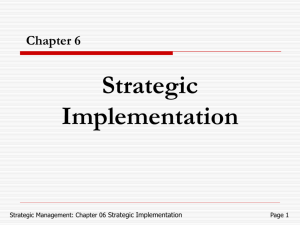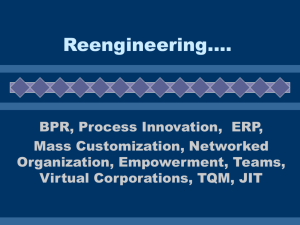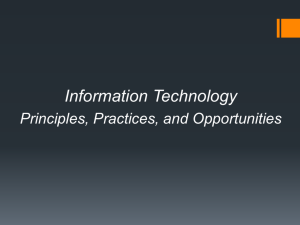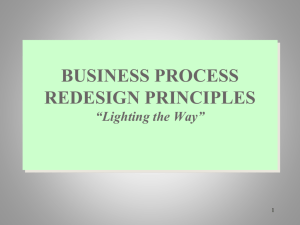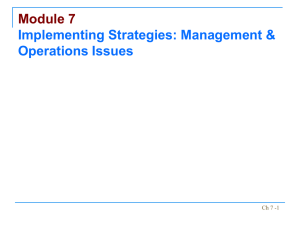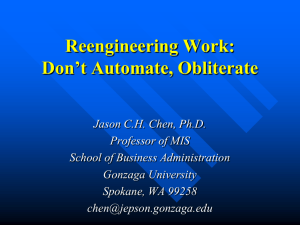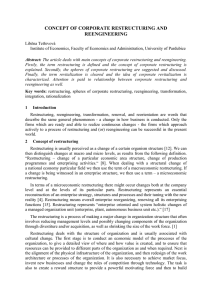Lecture 5 - cda college
advertisement
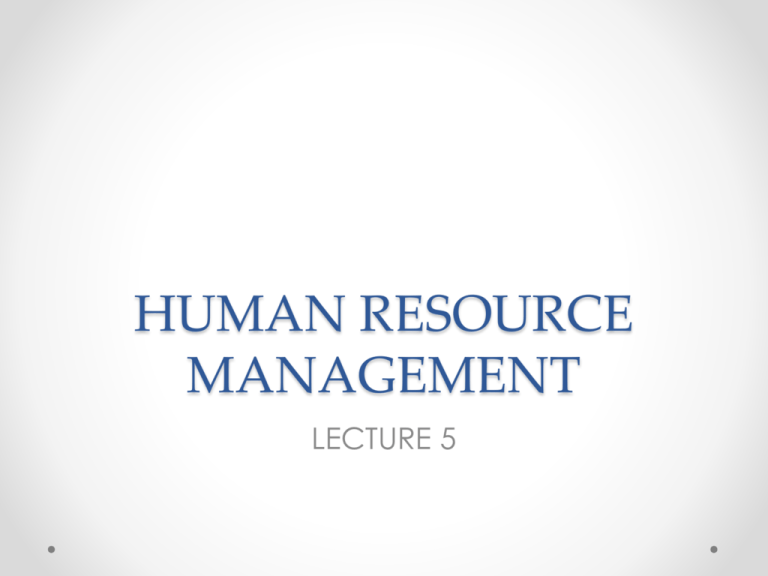
HUMAN RESOURCE MANAGEMENT LECTURE 5 What is structuring in organizations? STRUCTURING IN ORGANIZATIONS • Organizational structuring is defined as the sum total of the ways in which an organization divides and coordinates its labor into distinct tasks. Restructuring and reengineering in organizations • Restructuring the firm consists of altering its decision-making, operating divisions, and management culture. • Reengineering entails changing the procedures by which the work is accomplished and products delivered. RESTRUCTURING The restructuring is a process of making a major change in organization structure that often involves reducing management levels and possibly changing components of the organization through divestiture and/or acquisition, as well as shrinking the size of the work force. Restructuring deals with the structure of organization and is usually associated with cultural change. The first stage is to conduct an economic model of the processes of the organization, to give a detailed view of where and how value is created, and to ensure that resources can be provided to different parts of the organization as and when required. Next is the alignment of the physical infrastructure of the organization, and then redesign of the work architecture or processes of the organization. It is also necessary to achieve market focus, invent new businesses and change the rules of competition through technology. The task is also to create a reward structure to provide a powerful motivating force and then to build individual learning - the encouragement for individuals to acquire the new skills necessary for the success of the transformed company. The final stage is to develop the organization which will be able to adopt constantly to changing circumstances. Primary Spheres of Restructuring The following can be considered as primary spheres of a company restructuring: • financial (a financial and ownership company structure); • property (a property company structure); • production (it concerns both produced products and provided services, and used production facilities or technologies, but also an organization of a production process); • sales and purchases (oriented both on inputs and outputs of the organization); • organization (organization company structure defining function roles and relations in • business processes); • information (information systems in a complex concept); • personnel (human resources – volume, structure, quality). RE-ENGINEERING The traditional definition of reengineering claims that an enterprise reengineering represents a “vital rethinking and radical reconstruction (redesign) of enterprise processes so that dramatically improvement can be obtained in terms of critical measures of efficiency such as: costs, quality, service and speed”. Reengineering focuses on remodeling enterprise processes that are thus straightened – it strives for eliminating all useless duplicate activities, uniting the activities and innovating the ineffective ones. The essential types of reengineering according to Ivanov, are transformation, integration and rationalization. Transformation represents deep rethinking of a company mission, strategy and enterprising, it is often interconnected with external conditions and concerns the whole company structure - in terms of property, finance, supply, production, sales and partners. Integration then means reviewing, design of new company visions and ideologies, leads to a new company architecture, focuses primarily on company processes – emphasizing integration effects in structures, working methods, positions, functions, discreet company processes or a social system. Rationalization or redesign represents simplification of processes or parts of company structures, tends to the process of a quality improvement as there is nothing radically changed and in fact it preserves “status quo“. Reengineering has earned a bad reputation. Why? Reengineering has earned a bad reputation because such projects have often resulted in massive layoffs. This reputation is not all together warranted. Companies have often downsized under the banner of reengineering. Further, reengineering has not always lived up to its expectations. The main reasons seem to be that: • Reengineering assumes that the factor that limits organization's performance is the ineffectiveness of its processes (which may or may not be true) and offers no means of validating that assumption • Reengineering assumes the need to start the process of performance improvement with a "clean slate", i.e. totally disregard the status quo • According to Eliyahu M. Goldratt (and his theory of constraints) reengineering does not provide an effective way to focus improvement efforts on the organization's constraint. Organizational Performance Organizational performance comprises the actual output or results of an organization as measured against its intended outputs (or goals and objectives). (According to Richard et al. (2009) Organizational performance involves the recurring activities to establish organizational goals, monitor progress toward the goals, and make adjustments to achieve those goals more effectively and efficiently. (Carter McNamara, MBA, PhD, Authenticity Consulting, LLC.) Which factors affect organizational performance? • Part of an organization’s performance are the employees performance. What are the factors affecting the employees performance? Factors affecting employee performance Job Fit Employees must be qualified to perform a job in order to meet expectations. The best fit for a job is identified by skills, knowledge and attitude towards the work. If an employee is in the wrong job for any of these reasons, results will suffer. Technical Training Employees can bring skills to a position but there are likely to be internal, company- or industry-specific activities that will require additional training. If a process requires a new software package it's unrealistic to expect employees to just figure it out; they should receive adequate training. Clear Goals and Expectations When everyone understands the targets and expected outcomes, it is easier to take steps to get there and measure performance along the way. Organizations without clear goals are more likely to spend time on tasks that do not impact results. Tools and Equipment Just as a driver needs a vehicle in operating condition, employees must have the tools and equipment necessary for their specific jobs. This includes physical tools, supplies, software and information. Outdated equipment, or none at all, has a detrimental affect on the bottom line. Morale and Company Culture Morale and company culture are both difficult to define but employees will be able to report when they are poor or positive. Poor morale exists when there is significant whining, complaining and people just don't want to come to work. On the positive end, the workplace is energized by a sense of purpose and teams that genuinely want to work together. Motivation To get the best performance from employees, there needs to be some sort of motivation beyond the weekly paycheck. Motivation can come in the form of financial incentives, the opportunity to get involved in company projects, a career path that leads to management and direct involvement from management into the daily tasks. Effective motivation can create a productive work force, but a lack of motivating factors can leave employees searching for reasons to give their maximum effort. Commitment Employees that feel as though the company has made a commitment to employee success tend to perform better, according to Personnel Systems Associates. Commitment means offering a competitive rate of pay and benefits package, offering assistance in paying for employee's higher education costs, developing a regular training schedule that keeps employees updated on company changes and gives pertinent information for employees to do their jobs and upgrading equipment to make sure that employees have the most efficient technology available to do their work. Commitment shown by the company is returned in the form of commitment from employees. Employee Evaluations An effective employee evaluation is an interactive process where the manager gives his input on the employee's performance, and the employee gets the chance to point out what she has learned throughout the year. Managers create a plan along with the employee for the coming year on how the employee can develop and improve their performance. Comprehensive employee evaluations are important to the ongoing performance of employees. What is organizational culture? Organizational Culture Organizational culture is the workplace environment formulated from the interaction of the employees in the workplace. Organizational culture is defined by all of the life experiences, strengths, weaknesses, education, upbringing, and so forth of the employees. While executive leaders play a large role in defining organizational culture by their actions and leadership, all employees contribute to the organizational culture. Organizational culture is the personality of the organization. Culture is comprised of the assumptions, values, norms and tangible signs (artifacts) of organization members and their behaviors. Members of an organization soon come to sense the particular culture of an organization. Culture is one of those terms that's difficult to express distinctly, but everyone knows it when they sense it. For example, the culture of a large, for-profit corporation is quite different than that of a hospital which is quite different than that of a university. You can tell the culture of an organization by looking at the arrangement of furniture, what they brag about, what members wear, etc. -- similar to what you can use to get a feeling about someone's personality. Changing the culture of an organization How can we change it? There are four primary ways to influence the culture of an organization. • Emphasize what’s important. This includes widely communicating goals of the organization, posting the mission statement on the wall, talking about accomplishments and repeating what you want to see in the workplace. • Reward employees whose behaviors reflect what’s important. • Discourage behaviors that don’t reflect what’s important. There is no need to punish or cause prolonged discomfort. Rather, you want to dissuade the employee from continuing unwanted behaviors by giving them constructive feedback, verbal warnings, written warnings, or firing them. • Model the behaviors that you want to see in the workplace. This is perhaps the most powerful way to influence behaviors in the workplace. For example, if you want to see more teamwork among your employees, then involve yourself in teams more often. What is organizational change? Organizational Change Organizational change occurs when a company makes a transition from its current state to some desired future state. Managing organizational change is the process of planning and implementing change in organizations in such a way as to minimize employee resistance and cost to the organization while simultaneously maximizing the effectiveness of the change effort. TECHNIQUES FOR MANAGING CHANGE EFFECTIVELY Managing change effectively requires moving the organization from its current state to a future desired state at minimal cost to the organization. Key steps in that process are: • Understanding the current state of the organization. This involves identifying problems the company faces, assigning a level of importance to each one, and assessing the kinds of changes needed to solve the problems. • Competently envisioning and laying out the desired future state of the organization. This involves picturing the ideal situation for the company after the change is implemented, conveying this vision clearly to everyone involved in the change effort, and designing a means of transition to the new state. An important part of the transition should be maintaining some sort of stability; some things—such as the company's overall mission or key personnel— should remain constant in the midst of turmoil to help reduce people's anxiety. • Implementing the change in an orderly manner. This involves managing the transition effectively. It might be helpful to draw up a plan, allocate resources, and appoint a key person to take charge of the change process. The company's leaders should try to generate enthusiasm for the change by sharing their goals and vision and acting as role models. In some cases, it may be useful to try for small victories first in order to pave the way for later successes.

